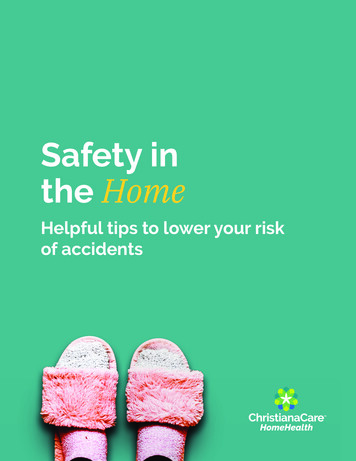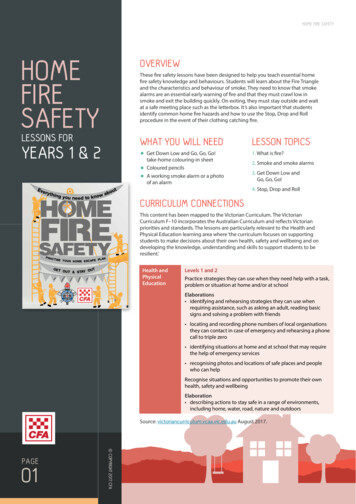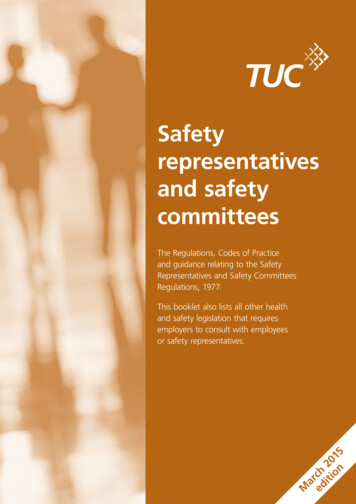
Transcription
Safety inthe HomeHelpful tips to lower your riskof accidents
Each year four out of every 10 peopleover the age of 65 will fall.Every 11 seconds, an older adult is treated in the emergency room for a fall;every 19 minutes, an older adult dies from a fall.Often these falls happen at home and can lead to serious injury.The good news is that many of these incidents can be prevented.ChristianaCare wants to help you make your home a safer place.Please use these tips to help prevent accidental falls in your home.ChristianaCare HomeHealth
Adapting Your HomeIt may be necessary to change the environment to make your home easier andsafer to navigate. Below is a guide to help you evaluate your home for safety risks.Place a checkmark next to items that apply to your home situation.Please note: All checkmarks indicate a possible safety risk and should be corrected immediately.Front/Rear and Garage EntryDo you need assistance to enter or exit your home?SAFETY TIPS:Entryways:Are there steps that don’t have railings?Are the sidewalks uneven and/or slippery?lHave a qualified individualinstall a ramp.lA single step should have agrab bar for support.Are there light switches far away from the doors?Are the light switches out of your reach?Do the inside doors swing out over the steps?Are shrubs growing too close to the entrance?Stairways:lStairwaysLiving Room:Are there hazards such as shoes, toys, etc., on the stairways?Are full length handrails missing or broken?Are the stairways dark?Are treads, risers and carpeting loose, broken or slippery?Is a light switch missing from either the top or the bottom of the stairs?Place a railing on both sides ofstairways.Living Room/Family RoomAre floor coverings difficult to walk over?Are door thresholds uneven?Are the doors too narrow or are they blocked in some way?Do you have trouble operating the door handles and knobs?Are electrical switches and outlets out of your reach?Are windows inaccessible?Are electrical cords covering or laying across walkways?Are scatter rugs unsecured?Is your furniture arranged in a way that makes it difficult to movearound freely?Do you need assistance to get up from your sofa or chair?Does your furniture slip on the floor?Safety in the HomelConsider changing round doorknobs to lever handles.lConsider a chair with arms foradded safety.lUse non-skid pads for furnitureon hard wood floors.lAll cords should be placedalong walls not under rugs oracross walking areas.
Adapting Your HomeSAFETY TIPS:KitchenIs it difficult to move freely?Kitchen:lKeep all pot handles turnedinward on stove.lPlace items frequently usedwithin easy reach.lNever stand on a chair to reacha high shelf.lPlace milk in small pitchers soit is easier to carry.Bathroom:lLeave bathroom doorunlocked.lNever use a towel bar forsupport.lConsider a shower chair orhand held shower.lRemove clutter from allsurfaces.Bedroom:lKeep a bell at your bedside tocall for help.lClose doors and drawers afteruse.lPlace frequently used clothingin top drawers of dresser foreasier access.Laundry:llAre the stove burner controls in an unsafe position?Is it difficult or unsafe for you to open and close the oven?Are oven mitts/potholders too far away from the stove?Are dishes/glasses/utensils difficult to reach?Are your pots and pans unmanageable?Is the counter too high for you?Is the counter cluttered or difficult to use?Is it difficult to reach or use the sink and faucets?Is the table cluttered or difficult to reach?Do you need assistance to open/close the refrigerator?Do you have difficulty carrying items to the table/counter/other room? BathroomIs the door too narrow, blocked or otherwise difficult to get through?Is there too little space to transfer on/off toilet?Is the height of the toilet adequate, too high or too low?Is it hard to access the sink and faucet?Is the mirror too high or too low?Is there too little room to get in/out of the tub?Are grab bars missing?Is the floor surface of the tub/shower slippery?Is it too difficult to stand long enough to complete your shower? Are items in the linen closet difficult to reach?BedroomConsider moving your washer/dryer out of the basement.Is the door too narrow, blocked or otherwise difficult to get through?Consider using a laundry bagwith a shoulder strap ratherthan a basket.Does the furniture make it difficult to move freely?Is the bed crowded so that you can’t get around it?Is the closet inaccessible?Is it difficult to access items in the drawers?ChristianaCare HomeHealth
Adapting Your HomeIs it difficult to get into or out of your bed safely?Does the bed slip on the floor?Is it hard for you to manage the bed covers once in bed?Do you have trouble getting to the toilet in the middle of the night? SAFETY TIPS:MedicationslBe sure your doctor hasa complete list of all themedications you are takingincluding herbal and naturalproducts.lCheck with your doctor if yourmedication causes you to feeldizzy or light headed. Exercisecaution when moving from aseated to standing position.Some medications mayplace you at a higher risk forfalls (examples: heart, bloodpressure, sleeping and waterpills).lKeep your medicine list withyou at all times. Place this listclose to your telephone in caseof an emergency. Are you unable to reach a lamp or flashlight while in bed?Is the room missing a sturdy armchair where you can sit to dress?LaundryIs the laundry area difficult to get to?Are you unable to move clothes from your washer to dryer safely?General TipsThis list applies to all rooms in your home.Keep a cell phone or cordless phone near you at all times.Be sure all hallway and stairway areas are brightly lit.Remove all clutter (boxes, stacks of magazines, toys, extra furniture).Get rid of all throw (scatter) rugs. Tack down loose or torn carpet.Use non-skid backing on all area rugs including bathroom throw rugs.Use non-slip wax on floors.ClothinglClean your eyeglass lensesfrequently and keep freshbatteries in your hearing aid.lWear short garments or pantsrather than long dresses androbes.lWear low or no-heel shoes thatfit well. Wear sturdy slippersthat have a back (not slip-ons)and non-skid soles.lTry using shoes with elasticlaces or Velcro closures.Apply red safety tape to the changes in surface levels (steps,thresholds) so they are easier to see.Be sure lighting is adequate. Install night lights or motion detector lightsin commonly used areas (hallways, stairways, bathrooms, bedrooms).Keep electrical and telephone cords out of walkways.Be aware of pets that can get under foot.Consider a personal emergency response system.Keep important phone numbers close to all phones and a phoneclose to your bed for emergencies.Consult a professional before investing in medical equipment.Clean up spills and wet surfaces immediately.Need Additional Information On Making Your Home Safe?If you feel additional information or an expert opinion is needed, you may be eligible foran in-home safety evaluation by a physical or occupational therapist. Please contactChristianaCare HomeHealth at 1-888-862-0001.Safety in the Home
ChristianaCare HomeHealth understands the healing power of home.Since 1922, ChristianaCare HomeHealth has been the leader in caring for people where they feelmost comfortable – at home. Just one phone call will connect you to a full range of professional andsupport services statewide: 1-888-862-0001.ChristianaCare HomeHealthNew Castle County Corporate HeadquartersOne Read’s Way, Suite 100New Castle, DE 19720302-327-5200Kent and Sussex County Office2116 S. DuPont Hwy., Suite 2Camden, DE 19934302-698-4300 (Kent)302-855-9700 (Sussex)ChristianaCare is a private nonprofit regional health care system and relies in part on the generosity ofindividuals, foundations and corporations to fulfill its mission. To learn more about how you can support ourmission, please visit: christianacare.org/donors.21HH2
including herbal and natural products. l Check with your doctor if your medication causes you to feel . an in-home safety evaluation by a physical or occupational therapist. Please contact . ChristianaCare is a










